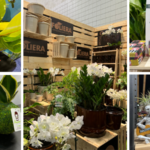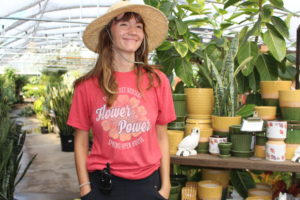Pick of the Pack Trials
It’s Pack Trial time again. Hard to believe, but the breeders/marketers are already tempting us with their new offerings for next spring. So if you’re still feeling overwhelmed from sorting through spring 2004, we do have one positive sign from this year’s trip: There were fewer really new introductions this year than either of the past three years. Our best estimate is 800 new varieties and 46 new series (not including entire category additions such as Proven Winner’s perennial line or S&G Flowers’ vegetative line). We know that still sounds like a lot, so we’ve tried to make it a bit more digestible.
We’ve distilled 10 days at Pack Trials and 800 new introductions into two digestible parts: major trends we saw this year and new varieties of note. The following is by far not all of the new introductions. For a complete listing from each company contact the breeder/marketer companies individually or your favorite grower.
Trends from the Trials
If you’ve visited all the sites year after year like we have, you start to notice trends. A certain crop might be hot one year, and it seems like every breeder/marketer has one. Or maybe a certain company has changed its exhibition philosophy. It’s something different each year. This year, we noticed a number of interesting things, none of which will have a direct impact on your operation, but they are interesting to note.
Probably the most obvious trend this year was introductions targeted directly to large growers and production for the mass merchandisers. There were two new seed impatiens series Xtreme from Goldsmith Seeds and Superseed from PanAmerican Seed and one gerbera color, ‘Festival Speedy Mix’ from Sakata/Dæhnfeldt. Actually targeting large growers with a certain line of genetics is a new development in our industry, and one that we’re certain to see a lot more of as the largest growers continue to get bigger and account for a larger share of total production. And it’s actually good for independent garden centers because it helps you identify which crops are best for your environment and which are not.
An important crop this year seems to be coleus in both seed and vegetative forms. We saw two new series introduced this year and 22 new varieties. And while we all think coleus is a great crop, even we’re starting to have a hard time telling the different varieties apart… there are just so many offerings on the market now.
The breeding/marketing companies must agree because most of this year’s introductions tout new textures instead of new colors. More duckfoot varieties from Ecke Ranch and some large-leaved specimens from PanAmerican Seed top our list of favorites. Another good point about the new coleus varieties is that they are not just for filler material in mixed containers anymore. Several of the new varieties are striking enough to be used as monocultures or as a mixed container focal point. Some even boast the ability to thrive in artificial light. The next big thing to look for in coleus: cut coleus.
If you are looking for height material this might just be your year. This seemed to be a big trend, as at several of the tour locations, we noticed mixed containers using “alternative” height components. Calla lilies at Golden State Bulb Growers, formium at Bodger Botanicals and woody material at Proven Winners the breeders/marketers have made it easier than ever to put together great mixed containers by emphasizing and bringing to market some great tall varieties, and they displayed them as such. Now, no one has an excuse for using a dracena spike as the only height component in combinations. (Look for more information about height component plants in an article next year.)
Though not a new trend, marketing programs continue to proliferate this year, with several smaller breeder/marketer companies such as Selecta First Class and Ernst Benary of America getting into the act. Unlike the first marketing programs in the industry, these new programs are not all-inclusive, often applying to only a segment of the company’s offerings. Such is the case with Benary’s Summer Sizzle and Fall in Love programs, which target seasonal sales. They offer consumers a reason to buy, such as summer bloomers, instead of just a name brand.
The new marketing programs include a range of over-sized tags, POP banners and signs, and various other support materials. Thanks to the advanced technology in pot printing, Selecta is offering a great four-color pot as part of its program. Benary, Ball FloraPlant and PanAmerican Seeds are all adding custom carts to their programs. And though the carts can be almost twice as much as a standard four-tier cart, they do look great with all the POP attached. Think what you will about whether or not marketing programs work; they’re here to stay.
As are the small breeder/marketer companies. There has been a lot of talk the past few years about how the three major brands The Flower Fields, Proven Winners and Simply Beautiful would affect the smaller breeder/marketer companies. Would the smaller companies try to get bigger? Would they just go away?
We got some answers this year. Some of the companies are trying to establish their own customer/consumer identity with marketing programs like the ones mentioned above; others are going back to their roots, so to speak, by trimming off excess products and focusing on what they do best. Oglevee, for example, has broken their relationship with PSI and will no longer carry a line of non-patented vegetative annual material. They made a point of telling us this was a conscious decision that would allow them to focus on the crops they do best, mostly geraniums.
It was good to see specialty companies narrow their focus concentrate on being the best at one thing. Just as it was good to see the opposite companies, especially the big boys, expanding their offerings to create a one-stop shop. We saw all of the major breeders adding crops to their lines. And though these introductions may not be a marked improvement over varieties currently on the market, they do offer more options and the opportunity to work with fewer suppliers.
Introductions to Watch
Argyranthemum (Ecke)
An exciting new argyranthemum series from Ecke Ranch is taking the “mum” to the next level. The Summersong series is a fully double compact series that has three colors White, Rose and Primrose and a whole bunch of breeding to back them up. This series is an improved branching version of the Summer Melody series.
Summersong has an upright mounding habit that basically needs just one pinch per plant, according to Ecke. These season extenders, blooming in both spring and fall, work best in 4- to 6-inch pots and can be finished in 8 weeks when grown cold. If needed, PGRs can be used, but no Florel is recommended. There should be a constant feed of 200-250 ppm nitrogen with complete micronutrients, and the growing soil should be evenly moist.
Begonia (PanAmerican Seed)
‘Babywing Pink’ is an exciting new addition to the Dragon Wing series from PanAmerican Seed. This begonia is very much like the standard Dragon Wing with its great heat and stress tolerances. These plants grow about 12-15 inches tall in the garden and spread approximately 10-12 inches.
The flowers are smaller with this variety, but it produces an abundance of light pink- to rose-colored flowers that are held above the foliage. The upright, oval habit is controlled, which helps with successful shipping. This very vigorous plant works best in 4- to 10-inch containers and 6- and 8-inch baskets. Babywing flowers about 2-3 weeks earlier than the standard Dragon Wing, and it loves the sun, even in humid areas.
Calibrachoa (Selecta First Class)
We know there are many calibrachoas on the market and a lot more introduced this year, but ‘MiniFamous Sun Blue’ and ‘MiniFamous Sun Pink’ introduced by Selecta First Class set a new standard for this crop. Both colors have an early flowering, semi-mounding habit, but it’s their vigor and heat tolerance that are really exciting. They start flowering early (not daylength neutral, but pretty low numbers) and continue through the heat of summer, reaching peak in mid-summer everywhere but the Deep South. Additionally, their low vigor and PGR receptiveness make them easy to produce in a 4-inch pot. Finally, a calibrachoa that looks good in a smaller format.
Sun Pink is our favorite because it holds its color better and stretches less, enabling summer production for the fall season. For best results, pinch after planting when new roots start to develop, and don’t forget that calibrachoas like an acid-based fertilizer that will keep pH in the necessary 6.0 range. Finish time from a rooted liner is 8-10 weeks for a 4-inch.
Coleus (PanAmerican Seed)
The new Kong coleus series from PanAmerican Seed definitely lives up to its name. The plant, bred by Sakata, has extremely large leaves that are monstrous in comparison to other coleus varieties, but it has a somewhat dwarf habit. The brilliant leaves are splashed with red, green, cream and burgundy, and no two plants are the same.
These well-branched varieties grow to approximately 18-22 inches tall in the garden. Unlike most coleus on the market, Kong can survive indoors as a houseplant, growing in artificial light. These fast-finishing plants are well suited to production in 41?2-inch to 1-gal. pots. There are five colors in the series.
The only note about this series is that it is not as aggressive as most coleus, so it tends to get taken over in mixed containers. It has good basal branching in the shade, and lean feed will keep colors bright. Plants will stretch under low light and may suffer leaf burn under high light.
Impatiens (Ball FloraPlant)
This new series of exotic impatiens from Ball FloraPlant is great for large containers because of its well-branched, mounded habit. Since it is a fast and easy crop, it is a good candidate for early sales. Five colors make up the Fusion series: Glow (yellow with pink blush), Heat (pink with yellow), Infrared (pink, orange and yellow), Radiance (coral with orange) and Sunset (apricot with pink).
This interspecies hybrid can be treated like a Fiesta. A Bonzi spray of 5-15 ppm is effective for height control. A Florel spray of 100-300 ppm can be used to improve branching but will not usually be needed. Start feeding immediately after transplanting. Proper environmental conditions will reduce or eliminate the need for PGRs. May need one pinch.
One thing to note: The foliage likes to grow up over the flowers. It needs to be grown lean and to prevent flowers from burying under foliage. Maintaining cold nights will also help with this. Hit it with a Bonzi drench when foliage reaches the side of pots for good presentation at retail.
Geraniums (Fischer USA)
Fisher, known for its geraniums, did not disappoint at this year’s Pack Trials. Growers can choose from a wide variety of bi-colors and growth habits. The new Holiday series Ruby Dream, Purple Dream and Rose have interesting and eye-catching bicolor flowers. Fischer has put 15 years of breeding work into achieving so many bicolor options, which is very uncommon, and you can definitely see that hard work in the habit, contrasting color and heat tolerance. Heat actually makes this series more stable.
‘Holiday Purple Dream’ has large, purple-white bicolor flowers and is a vigorous grower with very stable color. Ruby Dream is an eye-catching dark red-white bicolor. Rose has rose-white bicolor flowers and a nice mounding growth habit.
All Holidays are early flowering and have good heat tolerance. Purple Dream may require a bit more growth regulators than the others, but it has the most stable color and will not revert.
Ipomoea (Bodger Botanicals)
Ipomoea or sweet potato vine has become a standard foliage/filler for mixed containers, and the breeders/marketers continue to give us great colors to work with. One of the best so far is ‘Sweet Caroline Red’ from Bodger Botanicals. A beautiful purple-red color, Sweet Caroline Red fits with the series (Bronze, Light Green and Purple) for habit and performance and makes a great show.
This is an ipomoea series to keep in mind. It was developed to have short internodes, producing a more compact plant that will not take over a mixed container, and a smaller leaf size. In a 4-inch pot, with one cutting per pot, plants will finish in 4-6 weeks; a 6-inch pot with one cutting per pot will finish in 6-8 weeks. Odema will appear on ipomoea foliage during high humidity, but new leaves will cover stippling. Be aware that leaves start green but color up immediately, especially under high light. One pinch two weeks after transplanting into finish container will produce a fuller plant.
Linaria (American Takii)
Six new colors join the Fantasy series. This series had Fleuroselect award winners for Blue, Magenta Rose and Yellow. American Takii hopes to add to that with unique, darker colors that really stand out due to large flowers: Autumn Mix, Á Pink w/ Yellow Eye, Scarlet w/Yellow Eye, Violet w/ Yellow Eye, White w/ Yellow Eye and Formula Mix.
This series is a great cool-season, spring or late fall crop and can be grown throughout the winter in the South. It should be grown cool, with day temperatures at 65-70° F and night temperatures at 40-45° F. Watch out for heat, as Fantasy cannot tolerate prolonged periods of heat and high humidity. After transplant or at plug stage, drench with Bonzi at 2 ppm to prevent stretch in the warm weather until temps cool.
Pansy (Floranova)
The popular Chalon Supreme Mixed pansy from Floranova has been broken up into individual colors, making this the only series of ruffled pansies on the market. The individual colors include Blue/Yellow Bicolor, Flame, Purple Picotee, Rose Shades and Yellow Picotee. One of the more exciting things about this series is that though they tend to get a little smaller in the heat, the flowers do remain ruffled. According to Floranova, the plants have been improved for a better uniformity in plant habit and flowering time.
Chalon Supreme must be grown cold to get the full ruffled effect, and seeds need to be germinated at 59-64° F and grown at 41° F. Flowering time for Chalon Supreme is from spring until early summer. These pansies grow 5-6 inches tall with a flower size of 2-31?2 inches.
Phlox (Jackson & Perkins)
The new Astoria phlox series, from Jackson & Perkins (J&P), Suntory Collection, is one that will be very interesting for next year. This phlox series is being marketed as an annual, is very early to bloom and will provide continuous flowering that lasts all season long.
These heat-tolerant varieties have the same genetic base as the Intensia phlox series from Proven Winners. They are only available in rooted cuttings because they are somewhat sensitive to rooting, but once rooted, are great performers. The habit is more dense and less like a typical phlox. In the landscape, these plants have a mounding habit, reaching an average of 14 inches high and 24 inches wide.
There are five colors in the series, with a bit of variation in habit across the series. Cherry Blossom has the most compact growth of the series. It has light pink blush flowers with a darker pink star-shaped center. Magenta has deep magenta flowers. Pink White Star has bright rose/neon pink blooms with a white star-shaped center. Red has deep velvet flowers with a growth habit that stretches more than others in the Astoria series, so pinching is recommended. White has a more compact habit than the other colors in the series, and the foliage is slightly lighter in color. Currently there is more breeding being done with this series to make it more uniform.
Zinnia (Goldsmith Seeds)
The Magellan series from Goldsmith Seeds replaces the Peter Pan series. The difference? Magellan was bred for exceptional performance on the bench and in the garden, uniform habit, and a big difference, large, fully double flowers. The Peter Pan series had some single/double flower variance throughout the series. The Magellan series remedies that, and all colors Coral, Pink and Orange have fully double flowers. Also, while zinnias are usually susceptible to powdery mildew, Magellan was bred for good disease resistance. Already winning awards, Coral is an All-America Selections winner for 2005 (See Lawn & Garden Retailer June 2004).
Crop time from seed to finish is 6-7 weeks for packs and 7-8 weeks for a 4-inch. Watch for low light conditions, as it will promote stretching and alter its double flowers. So, during short days, it is recommended to light for two weeks after transplant to get fully double flowers. If not, the first flower will be single and the others double.

















 Videos
Videos





